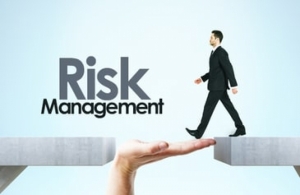عرض العناصر حسب علامة : إدارة المخاطر
رسالة دكتوراه: دراسة العلاقة بين مشتقات الائتمان وتقييم الائتمان في البنوك المصرية
شهدت أسواق المشتقات الائتمانية Credit Derivatives نشاط غير عادي في العقد الماضي، وخاصة مع تطور عقود المبادلات، وظهور محفظة المشتقات الائتمانية، والتي يطلق عليها التزامات الديون المضمونة
رسالة ماجستير: مدخل مقترح دور المحاسبة الإدارية في إدارة المخاطر بمنظمات الأعمال
يتمثل الهدف الرئيسي للبحث في اقتراح آليات لتطوير الدور الذي يمکن أن تؤديه المحاسبة الإدارية في عملية إدارة المخاطر بمنظمات الأعمال المصرية.
معلومات إضافية
- البلد مصر
برايس ووترهاوس كوبرز تضيف 100 ألف وظيفة!
تستثمر شركة برايس ووترهاوس كوبرز 12 مليار دولار عبر أعمالها العالمية في إصلاح شامل يستهدف عمليات تدقيق أفضل
معلومات إضافية
-
المحتوى بالإنجليزية
PwC to add 100K jobs in $12B strategic revamp
PricewaterhouseCoopers LLP is investing $12 billion across its global business in an overhaul targeting better audits, digitization of services and greener operations.
The professional-services provider will hire 100,000 employees and develop the skills of existing staff over the next five years as it seeks to respond to the post-pandemic operating environment, it said in an emailed statement on Tuesday.
“We will continue to evolve our ways of working, and expand our capabilities in the areas that matter most for the future, while remaining steadfast in our commitment to quality,” PwC Chairman Bob Moritz said. “We want our people to be the most sought after in the market.”
Auditors are grappling with managing quality amid a shift in ways of working introduced by the COVID-19 pandemic. The International Auditing and Assurance Standards Board has revised standards for auditors, coming into effect in 2022, to boost technology use, help manage new risks, and improve quality management.
PwC is also seeking ways to address growing calls for transparency in the profession from stakeholders after several accounting scandals among the Big Four auditing firms knocked public trust. In South Africa, for example, KPMG has put in place a variety of reforms after it came under fire in 2017 for work done for a politically connected family accused of plundering the government’s coffers.
The South African unit of PwC will add at least 2,500 new employees over the next five years, Chief Executive Officer in the region Dion Shango told reporters in a conference call. Across Africa, where it has a presence in 34 countries, the firm plans to bulk up its operations with a $400 million investment. The company is also interviewing for non-executive directors to strengthen audit oversight.
PwC has also set aside $3 billion of its total global investment to help double the scale of its Asia-Pacific operations, it said. The firm’s spending will also focus on responding to environmental, social and governance trends across its operations.
كيف يمكن للثقافة أن تطلق العنان لإمكانيات التصنيع 4.0؟
معلومات إضافية
-
المحتوى بالإنجليزية
How culture can unlock the potential for Manufacturing 4.0
In many companies with manufacturing operations, we can find pockets of excellence where enlightened leaders have built teams that function like fine watches. They have a culture, a way of working, wherein each person knows what to do and how to do it well as part of a team. There is a connectedness in these groups, supported by shared understanding and a focus on getting results. The members in such teams move as one, addressing constraints and challenges and handling them in stride. They protect and create value for the team through deliberate action, but these actions come naturally because they are a part of a group.
What if an entire function, or even a company, could work this way?
A growing number of manufacturing companies are taking more purposeful steps to drive behavior change — which, at scale, can be called culture change. The conversation at the executive level has rightfully shifted from “should we implement culture change?” to “how do we implement culture change?”
As ongoing crises have both necessitated and allowed for behaviors to change quickly, culture is now well recognized as an intangible asset that separates great companies from those that are just good. Manufacturers of all sizes need to build a culture that suits their operational environment — one that focuses on the few, practical behaviors that are both good for the business and for the people.
1
Chapter 1
Create the first line of defense
The health of a company’s culture can go a long way in defining the health of a business.
How EY can help
Smart Factory
EY Smart Factory arms your shop floor with dynamic predictive data analytics, virtual reality and artificial intelligence to deliver unprecedented performance.
Read more
Corporate culture, defined simply as the behavioral patterns of the people in a company, is now measured, managed and reported on by most leading companies around the world. On average, more than 50% of a company’s market value is now derived from intangible assets, and for some industries, that value can be as high as 80%.1
A workplace culture typically comprises three parts: mindset (how leaders think and influence others), behavior (what leaders actually say and do) and skill (the ability of the people in a company to perform). These three elements can drive a company forward, and when they work in agreement, the result is an organization built around leaders who convey a consistent message about how things are to be done and a team that has the skills to drive the right performance.
The next step is forming an environment that both creates and protects value through its people. Day-to-day personal behaviors, based on shared beliefs and aspirations, more powerfully influence an organization’s actions than formal mandates or controls can. Without a cultural foundation of integrity in place, an organization risks failure. But, with that foundation, an organization can innovate, manage risks, adapt to changes and meet stakeholder commitments.
The following are behavioral accelerators that can bring companies closer to these goals and create value in their organization:
Make values real on the ground with behavioral expectations and modeling
Break down the activities that people need to do, into small behaviors so that they can be nudged in the flow of their work
Leverage value proposition to attract talent and customers
Link performance metrics and incentives to the behaviors needed
Companies should also be aware of risk and potential negative behaviors that could impact their performance. Firms must ensure that their culture (normative behaviors) matches what their control environment calls for. These can easily be taken for granted in a company that hasn’t been through a difficult situation related to behavior by its personnel. Organizations must be sure to continue behavioral accelerators and take steps to ensure that their code of conduct is followed and that decisions align with their company’s risk appetite. They can create worth by increasing the presence of value-creating behaviors and protect by decreasing the presence of value-eroding behaviors.
2
Chapter 2
Break down behavioral barriers
Breaking behavior down to something simple to do is what makes change possible.
To bring new value, we need people to use different words, to make choices in their day-to-day work, and to behave or perform a little differently on a task or in a meeting. Those are seemingly simple, small things, but they are not easy to shift.
To illustrate, the EY team had a manufacturing client looking for ways to unlock innovation in its business. The team defined what innovation meant behaviorally and very specifically through a series of leadership discussions and focus groups. They met with people out in the field and helped the company develop a strong operational and practical working definition for what innovation looked like in daily practice. The team talked about steps that could be taken to free people from unnecessary constraints so that their ideas could come forward.
In this case, it wasn’t about doing more, but about doing less so that they could do “new.” Redundant efforts were eliminated, unnecessary approvals were removed, and meetings were shortened and better managed. People then started to have more time to think and improve things around them, and not just participate in meetings or operate a process.
Many leaders agree on bureaucracy being the biggest barrier to unlock innovation. As the EY team went through a process of defining from-to behaviors, they came to find out the company had, on average, 17 layers of approval for a relatively small, US$50,000 capital expenditure in the company. Nothing will stifle innovation like that type of bureaucracy. What the team did to ultimately unlock innovation, but more specifically, unlock small behaviors on the ground, was reduce the number of steps from 17 layers to 5.
It turns out these layers were just bolted on over the previous 15 years. It was an old process that no one really understood or needed, but no one had ownership or took the time to examine and simplify. In a conversation where a leader says, “Well, I have to send this to finance because finance requires it to go up to this person,” what the leader doesn’t realize is that the person in finance is probably saying, “I don’t need that. I don’t even look at that.”
It’s often a matter of work simplification to allow people the space and support to actually do what comes naturally to them, to make an idea better, or to serve a customer differently. This results in unlocking the potential for value that’s already there. It just takes a willing and aware leadership team to clear such obstacles out of the way. That’s a different, more meaningful approach, than for example talking about what agility means or creating a list of six things needed to be agile. Companies must blueprint what needs to be done, find the things they can clear out of the way and have a process in place to stop behaviors that might be holding a team back from delivering what it naturally wants to.
3
Chapter 3
Address behavior change directly
Bringing people along shouldn’t be an afterthought or relegated to HR.
If transformation of any sort is on the agenda, companies must be prepared to go at behavior change as deliberately as they would putting in a new technology or shifting a business process. Behavioral analytics and behavioral science practice are too good today for business leaders to ignore.
Behavior is said to be motivation times ability times a prompt. Firms must blueprint behavioral changes they need, create the psychological safety that motivates people to lean into their natural skills, then prompt them consistently to work that way. If companies don’t make team-level behavioral expectations clear and consistent, they will be hard-pressed to sustain any form of change.
Building the behavioral changes in teams aggregates to a culture where each person and the collective have this mindset. At the same time, it needs to be an environment in which concerns can be addressed without fear of reprisal. If there is a mid-level manager in a firm who works on the floor and has grown frustrated at the layers of approval necessary to get a needed expenditure approved, they need to have a safe channel to express this concern. What if there was a new piece of equipment that could save the business serious time and money, but the process for bringing ideas was so risky or heavy that the manager just didn’t bother?
Imagine each local leader rolling a rock off the productivity path each day. In time, companies can hit a behavioral tipping point where a new operational culture takes hold, one in which ways of working fit with strategic agendas.
We see many companies where transformation agendas are ambitious and sophisticated, and where leaders have lost the practical connection to what’s happening on the floor.
4
Chapter 4
Prioritize the institutional boulders
Senior leadership must prioritize what roadblocks to remove.
The path to realizing M4.0 will be blocked with institutional boulders, such as antiquated incentive systems, and the aforementioned small rocks that companies need local leaders to roll each day. At the senior level, leaders must identify the big boulders, such as governance, operating models, performance systems, rewards systems and business processes, that must change to shift and sustain new ways of working. Leaders must prioritize one boulder at a time so that the management can put their collective shoulders into rolling it forward.
Outside of the senior leadership team, we must identify the influencers who are open-minded and ready to do things differently. With these people at the forefront, companies can run new behavior plays through a behavioral playbook. Over time, these new behaviors create new norms that can be promoted to other teams as an innovative way of doing things.
Although we often think that small firms or technology companies are best able to drive modern cultures, size and age are not barriers to a healthy, differentiated culture. Heritage, history, and purpose are huge advantages if firms tap into and celebrate them well. And they can be as inspirational as any progressive mantra of a technology company. This point needs emphasis: being large and having a rich history are advantages, not disadvantages. There is no shortcut to instilling legacy and wisdom into a firm’s culture. If companies have these already, even if they are shrouded in current challenges, they have something great on which they can build. But build they must. Every organization of any size, shape, and age must shepherd its culture to stay fit over time.
In many instances, manufacturing companies have built a legacy by creating quality products and consistently responding to the needs of their customers. The leaders of these companies should have a system in place that ensures that this history becomes embedded in the company’s culture and thus is continuously passed from one generation to the next. When new employees are hired, they should be paired with mentors who can share their experiences and lessons learned to create a sense of belonging and an obligation to carry on the traditions of the business.
As manufacturers confront changing dynamics in their industries, and new ways to get work done, they must consider the impact of these changes on their culture. It’s not about transformation or making wholesale changes. Rather, it’s about shifting the workplace environment to ensure that teams have the mindset and the training they need to evolve with the times to drive the company’s competitive position in the market.
المخاطر والأداء
معلومات إضافية
-
المحتوى بالإنجليزية
Embedding risk practices successfully can be challenging. There are many things to consider when it comes to risk management. But it’s an essential element in the success or failure of organisations. That’s why it’s important to learn what effective risk management actually means.
How do we achieve effective risk management?
Effective risk management within organisations can only be achieved when staff are willing to engage in risk management activities. Only then can the board’s risk taking and control objectives be achieved. In short, risk management cannot be effective if it is not embedded.
To be able to do this, we need to understand how board-level risk taking and control objectives translate into the risk management activities. That includes recognising how these activities are performed within organisations.
Organisations are taking different paths to embedding risk management depending on the external environment in which they operate. A range of internal factors, such as leadership tone and the success or failure of past risk management initiatives, also contribute to the varied approach to risk management.
Key findings
Effective risk management requires the use of complementary formal and informal mechanisms and tools
Communication is vital. This includes communication between business units and functions, as well as communication to/from the risk management function and internal audit function.
The risk management function has a pivotal role in communication and building risk management relationships.
The risk management function does not only design and implement risk identification, assessment and reporting tools; it must also work hard to explain and even sell the benefits of risk management to the wider organisation.
The mix of formal and informal is key
Although tools are needed, embedding risk management is about much more than formal tool design. Complex tools may not be required. Simple tools, complemented by a broad suite of regular informal mechanisms (one-to-one meetings, etc.) may be more effective than complex tools in embedding risk management.
There are no easy answers or quick fixes when embedding risk management. What works differs from one organisation to the next. Nevertheless, it is possible to identify common challenges and good practices to overcome these challenges.
دراسة ماجستير: دور إدارات المراجعة الداخلية في تفعيل مبادىء الحوكمة
دراسة ماجستير: استخدام منهج سيجما ستة SIX SIGMA في ضبط جودة التدقيق الداخلي
تسعى المنظمات بشقيها السلعي والخدمي إلى تطبيق منهج سيجما ستة Six Sigma الذي يقوم على مراقبة الأداء والأنشطة والأعمال اليومية للوصول إلى درجة عالية من درجات الجودة يتم فيها تقليل الفاقد وفرص المعيب بالشكل الذي يؤدي إلى تلبية احتياجات العملاء










